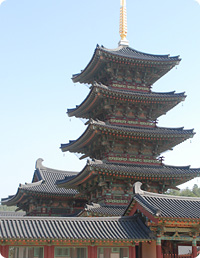EXCURSIONS
Central Korea (B) 6 days
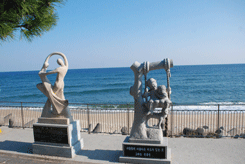
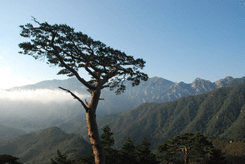
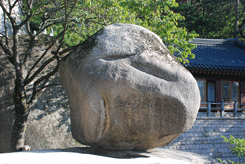
Tour Highlights
- Unification Observatory
- Seoraksan National Park
- Woljeongsa Temple
- Hwanseongul Cave
- Hwangji Pond
- Coal Museum
- Dossanseowon Confucian Academy
- Hahoemaeul Village
- Songnisan National Park
- Beopjusa Temple
- Hwaseong Fortress
Click on the days to access the program quick
| Days | Visits and Activities | Distance |
| Day 1 | Seoul - Goseong - Seoraksan | 280km |
| Day 2 | Seoraksan | |
| Day 3 | Seoraksan - Odaesan - Jeongseon | 160km |
| Day 4 | Jeongseong - Hwanseongul - Taebaek - Dosan - Andong | 240km |
| Day 5 | Andong - Songnisan | 140km |
| Day 6 | Songnisan - Suwon - Seoul | 190km |
Day 1 Seoul - Goseong - Seoraksan (- - -) 280km
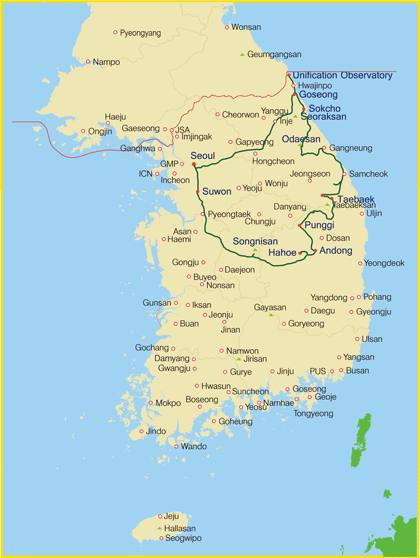 Your tour guide greets you in your hotel lobby and takes you on an excursion to Seoraksan national park. As you make your way to the east coast, enjoy the picturesque countryside, tranquil nature and beautiful landscape. At the northern tip of the east coast sits Unification Observatory. With the entry permit and sign to place in the vehicle window ready, continue towards the north, driving past lots of tank traps comprising large lumps of concrete set on either side of the road, all a strange and eerie reminder of the tensions that exist between the two Koreas and the stark reality of the divided country. While there, you will get a glimpse of the much talked about border dividing the two Koreas and see the road and train track stretched side by side ahead across the North Korea.
Your tour guide greets you in your hotel lobby and takes you on an excursion to Seoraksan national park. As you make your way to the east coast, enjoy the picturesque countryside, tranquil nature and beautiful landscape. At the northern tip of the east coast sits Unification Observatory. With the entry permit and sign to place in the vehicle window ready, continue towards the north, driving past lots of tank traps comprising large lumps of concrete set on either side of the road, all a strange and eerie reminder of the tensions that exist between the two Koreas and the stark reality of the divided country. While there, you will get a glimpse of the much talked about border dividing the two Koreas and see the road and train track stretched side by side ahead across the North Korea.
Stop at DMZ museum (closed on Mondays) offering very surreal experience of a lifetime. In the hopes of bringing peace to the country from the painful past, the museum presents the South Korean side of the conflict with the North, underscoring the historical significance of the DMZ and embracing everything about the latest efforts made to transform the DMZ from a place of political scars to a symbol of peace and ecology.
Enjoy a short tour of Socho that has so much more to offer than just mountains. In downtown, there is a colorful market selling fishes, fruits, vegetables, grains and daily necessities, and a little further down is a North Korean refugee village that can be accessible by a hand-pulled boat. At Daepohang, you will see a wide variety of fresh seafood harvested from the nearby sea and a number of small restaurants serving sliced raw fish. You will find something to enjoy, from simply feeling the ambiance of this small fishing port to taking picture.
Seoraksan national park is a place that you can definitely find lots of outdoor activities to make it worthwhile for an extended stay. The dense forests bordering crystal clear streams which tumble over cataracts and drop from precipices to form white waterfalls, as well as awesome saw tooth cliffs spiraling into the blue skies, and scenic valleys altogether make this park and surrounding area some of the most beautiful sceneries on the Korean peninsula, and give this area an unparalleled popularity around the year.
Day 2 Seoraksan (B)
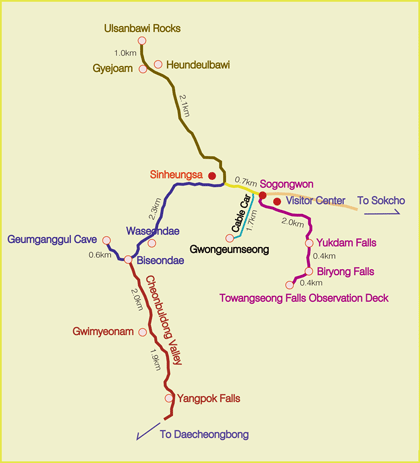 The word of the day is hiking of varying lengths and difficulty. All route types are out and back. Today, you will form your own independent tour to explore Seoraksan national park that has many different trails, and you are free to pick and choose which ones you want to do.
The word of the day is hiking of varying lengths and difficulty. All route types are out and back. Today, you will form your own independent tour to explore Seoraksan national park that has many different trails, and you are free to pick and choose which ones you want to do.
Only a small walk from the park entrance (Sogongwon), you will marvel at a large bronze statue, Unification Buddha, symbolizing Korean people's hope for reunification of the country. A little further on is Sinheungsa temple which claims to be the Korea's oldest Zen temple. Left trail in the direction of the temple is a trailhead of Cheonbuldong valley, the most impressive valley in the park, leading finally to the Daecheongbong peak of Seoraksan (1,708m), while right trail is up to Ulsan Bawi Rocks.
Among the most recommendable trails from Sogongwon are as follow and the given times below are based on round trip in a bit relaxed pace.


Cheonbuldong valley Trail
One hears many legends of the heavenly nymphs who come down to play at Biseondae while taking a bathe in the placid pools of the valleys that are hidden from the human eyes. Near Biseondae rises Janggunbong majestically and among the crags of it is a temple alcove, Geumgang cave. You may want to head up a very steep incline for 600m from the gentle slope of the trail, and you can scale only by carefully ascending the long, steep, metal stairs bolted onto the sheer cliff face. The hike, although hard, comes with a stunning view of numerous cliffy peaks and mountain valley. From Biseondae, another 3.5km to Yangpok Falls, so spacious yet everywhere you looked you are surrounded by giant mountain peaks.

Ulsanbawi Rocks Trail
About an hour and half into the walk from the park entrance is Gyejoam hermitage. Located at the base of Ulsanbawi, and the point at which the trail takes a sharp rise upwards. In front of the hermitage on a spacious stone slab is a huge spherical rock called Heundeulbawi. This rock is soperfectly balanced that it can be shaken with some effort, but nobody gets further than waggling it. Your adventure begins by climbing a massive steep staircase that winds its way up the side of the cliff that angle up Ulsanbawi which is in a folding screen shape made up of cliffs on all sides. It is a 1.8km-long ridge of naked, gray stone peaks jutting well over 800m into the sky.

Biryong waterfall Trail
The trail is relatively easy for anyone to try and you will view Biryeong waterfalls at the trail end. About 400m further above the falls, you will be amazed at Towangseong waterfalls cascading down a 320-meter cliff.
Cable Car
There is a cable car that picks you up at the valley floor to the Gwongeumseong. The peak is surrounded by cavernous drop-off cliffs, cloaked in more towering rocky summits. Definitely, you stand in awe on the top: sweeping panoramic views of the park around you, the Pacific Ocean, and the small beachside town of Sokcho. Be careful as always as there is not much room to move about and people constantly going up and down and moving around.
Hiking Trails
1. Biryong Falls (4.8km): 2 hours - Walking on a trail and suitable for whole family
2. Biryong Falls + Towangseong Falls Observation Deck (5.6km): 3 hours 30 minutes - Serious hiking from Biryong Falls to the observation deck
3. Biseondae (6km): 3 hours - Walking on a trail and suitable for whole family
4. Biseondae + Geumgang cave (7.2km): 4 hours 30 minutes - Very strenuous hiking from Biseondae to the cave
5. Biseondae + Yangpok (13.8km): 7 hours - Walking on a trail and no use of hands
6. Heundeulbawi (5.6km): 3 hours - Walking on a trail and no use of hands.
7. Heundeulbawi + Ulsanbawi (7.6km): 5 hours 30 minutes - Very strenuous hiking from Heundeulbawi
8. Gwongeumseong Cable car (3.4km): 1 hour (roughly four minutes each up and down)
Day 3 Seoraksan - Odaesan - Jeongseon (B) 160km
Start the tour with a visit to the magnificent Woljeongsa temple. Enshrined in the Main Hall is a statue of Sakyamuni, but the more important statue is a Bodhisattva, 1.8 meters high, probably a Medicine Bodhisattva. Said to have been found in the Diamond Pond to the south of the temple, the statue is offering something. The head is covered with a hat, the face is long and the ears are slightly hidden by long hair. Around the neck there are three lines which are so beautifully carved hat they look like necklaces. The elbow is resting on the head of a young boy. Next to the Bodhisattva is an octagonal nine-story pagoda which stands 15.2 meters high and is representative of the many-angled, many-storied stupas of the Goryeo Period. Another amazing part of the temple is the 800-meter road arched by 1,700 tall fir trees. You will stroll the path listening to the trickles of stream and smelling the fresh yet musky fir trees.
Explore Hwanseongul Cave. About 30 minute grueling uphill hike from the ticket office or a 6 minute on a mono rail gets you to a cave entrance of overwhelming size in the middle of the mountain. The cave itself is super massive and it would take well over one hour to explore. Be prepared for wet walkways, maneuvered up a narrow corridor with a rapidly flowing creek below it and hung off the side of the cave's walls above the creek. Many waterfalls are actively eroding the floor. Only 1.6km open to the public; yet that section alone will provide unforgettable memories. Cave tour is absolutely at your choice. You could opt out by staying outside, or simply relax.
Day 4 Jeongseon - Taebaek - Dosan - Andong (B) 240km
Taebaek is a highland town once boomed with coal mining until the early 1980s. There is a coal museum showcasing Korea's coal mining with well over 8,000 items including rocks such as silver, ore, fossils, and mining equipments and documents. You will also explore a mine simulation modeled closely after real mine showing how the mining work was like. Taebaek boasts of two river sources. Hwangji pond from which 5,000 tons of water flows daily is the source of the Nakdong River and Geomryongso is that of Han River. Travel to Andong, a stronghold of Confucianism that has deeply influenced the lives of Koreans in all aspects.
Continue south to Dosan Seowon, a Confucian academy founded in 1574 to honour Yi Hwang, one of South Korea’s most influential scholars. At its peak, hundreds of such academies existed across the country, serving both as memorials and as places of learning. Most were closed in the 19th century, but Dosan Seowon survived and today consists of 16 traditional buildings built in a simple yet harmonious style.
Walking through the courtyards and wooden lecture halls, you can sense how deeply Confucian ideals shaped South Korean society - emphasizing respect for learning, moral discipline, and social order. Although the academy no longer functions as a school, it is recognized by UNESCO as part of the “Seowon, Korean Neo-Confucian Academies” World Heritage listing, highlighting its enduring cultural significance.
Day 5 Andong - Songnisan (B) 140km
You will explore UNESCO World Heritage Site, Hahoemaeul from the 15th century. It is the best preserved traditional village portraying and spanning the life of the Joseon Dynasty (1392-1910) and some 480 Korean traditional houses, both large and small, are still fully functioning. As you take a walk in the narrow alleys, enjoy the rustic and old charm of this unique village. You cannot possibly miss a 600-years old zelkova tree, the home to the village spirit. At the tree's base is where residents still make their wishes. The village is also known for traditional festival, Hahoe Mask Dance which gave common people the opportunity to mock those in authority, and in particular the Byeolsingut, a shaman ritual exorcising evil spirits, dating back to the Goryeo dynasty (918-1392).
Your journey continues to Songnisan national park, weaving through the picturesque countryside. En route, make a short stop at a 600-year-old pine tree shaped like an open umbrella. In recent years several branches were damaged by wind and snow, though what remains is still beautiful. Upon entering Beopjusa dating back to 553, you will certainly stand in awe before the enormous golden Buddha gazing down at the temple and a five-story wooden pagoda, the only one left in Korea. Check out a giant iron pot whose diameter is 2.7 meters that may well had been used to feed 3,000 priests in the early 12th century. A stone carved lantern supported by twin lions standing face to face is a rare example of the magnificent Silla sculptures. A stone water cistern is considered unique for beauty and design. Two stone pillars once held the temple banner pole. An excellent carved relief called Maaebul and worship halls also can be seen.
You cannot miss Four Buddhist Instrument Ceremony. The sounds of each instrument, Brahma bell, Dharma drum, wooden fish and cloud-shaped gong, have a function in saving beings of other realms. Hearing them reverberating through the universe, you will reflect upon the profound symbolism of the instruments. It is a great vow to save or enlighten the creatures in the universe including those on land, in the sea, in the air and in hell.
Day 6 Songnisan - Suwon - Seoul (B) 190km
While in Suwon, explore UNESCO World Heritage site of Hwaseong Fortress from the 18th century. Though it is relatively small in scale, it is well acknowledged as the best structure of its kind ever built in Korea. A 5.74km-long fortress enclosing both flatland and hilly terrain is parapeted with crenels and merlons and highlighted by four main gates and well over 50 structures including temporary palace where the king sought refuge during war and found rest during times of peace. A walk through the whole fortress could take several hours but it is well worth making a short walking tour to enjoy the splendor of the fortress, including the Korea's largest Janganmun Gate.





